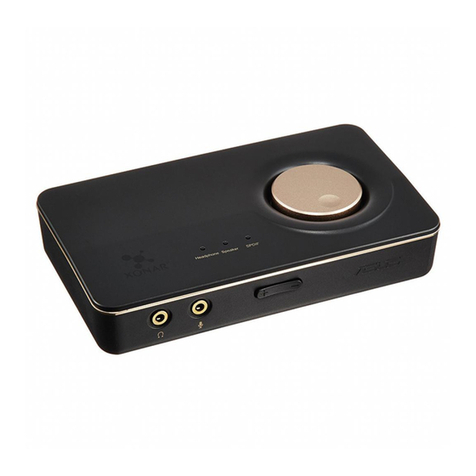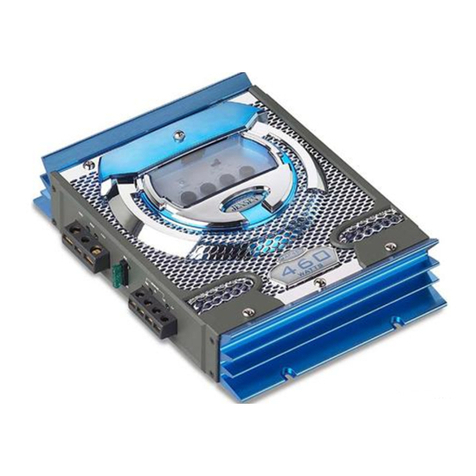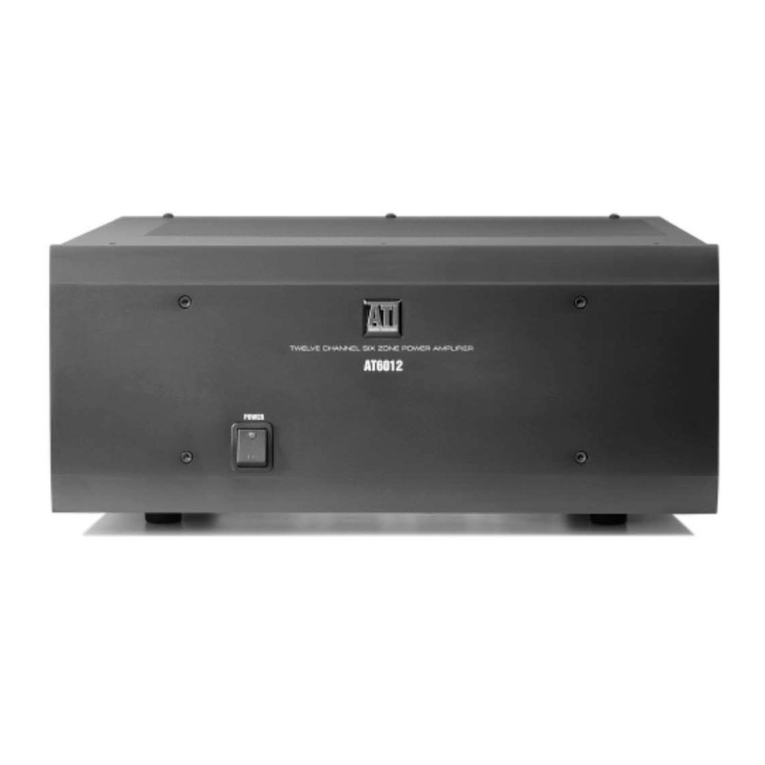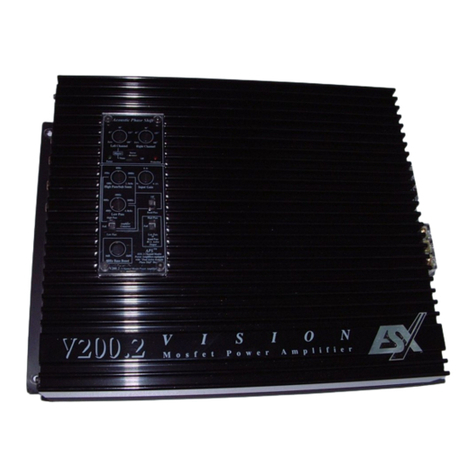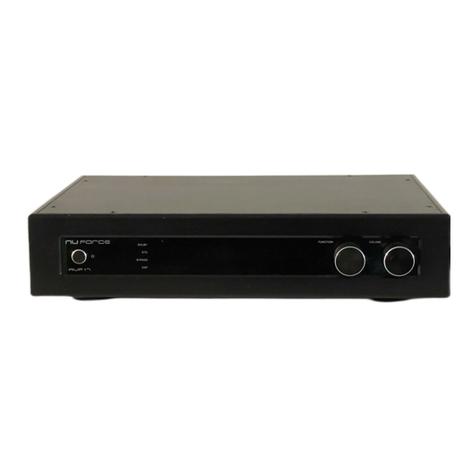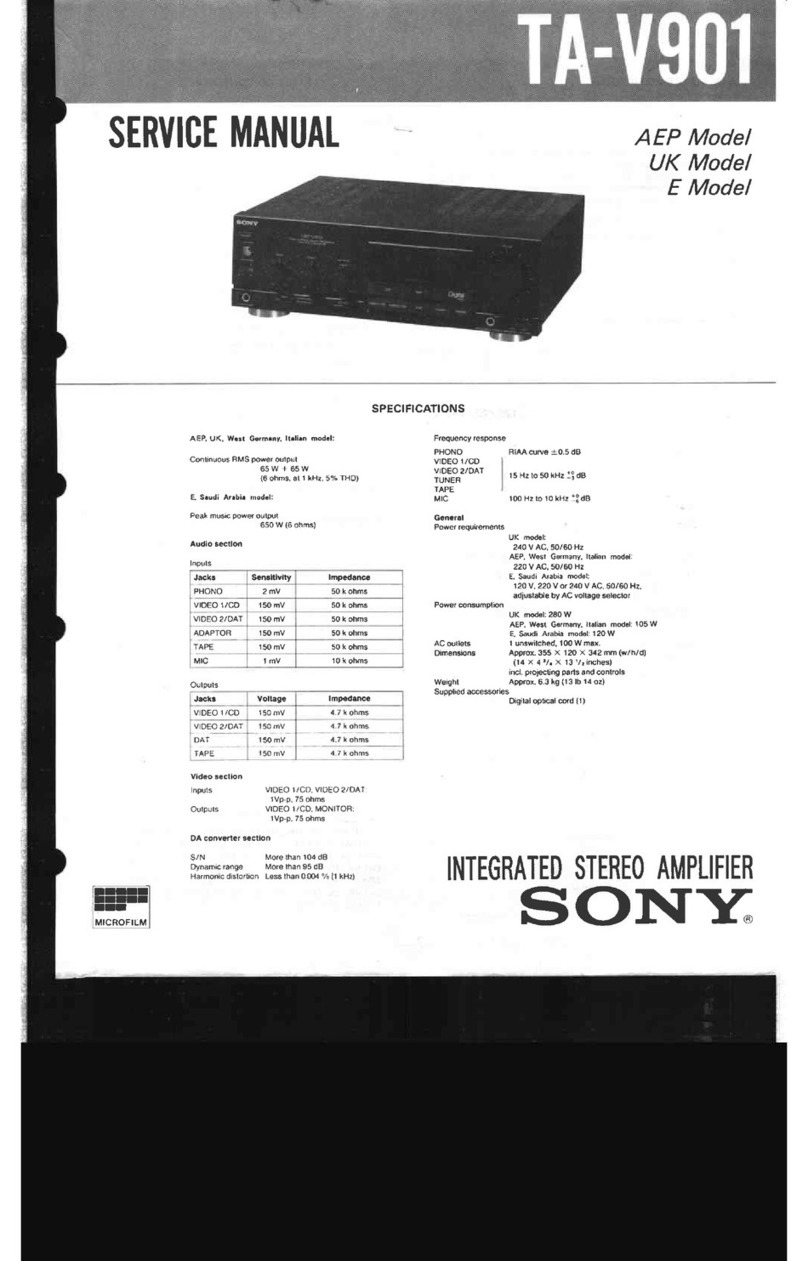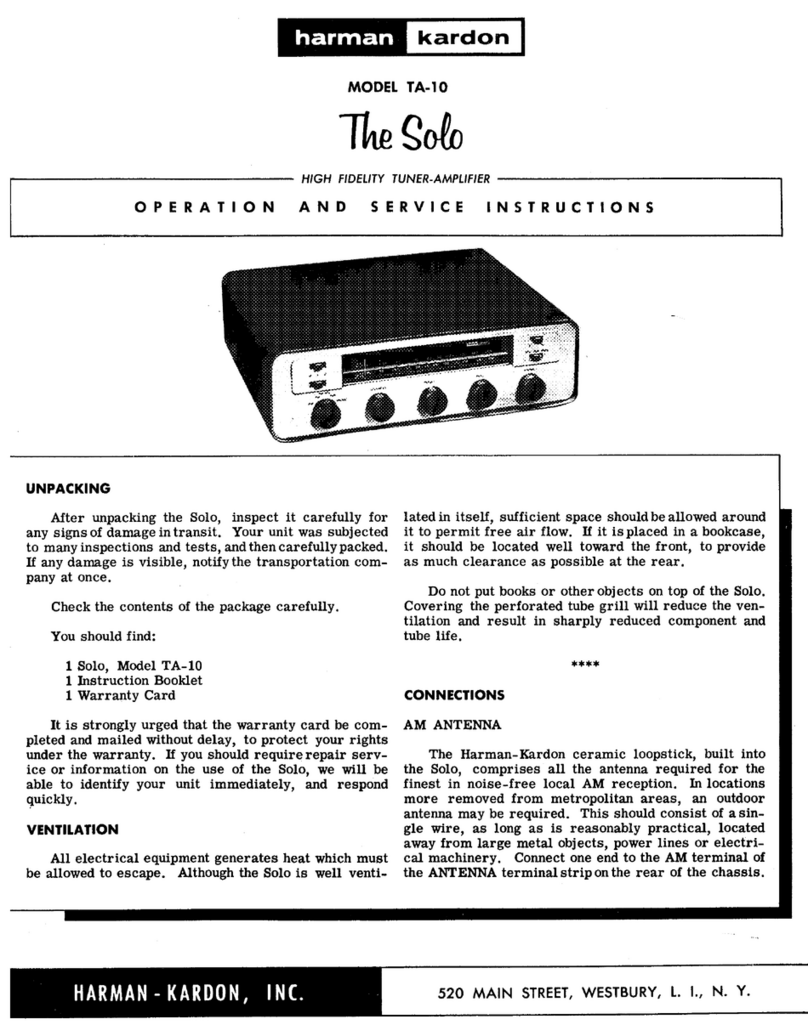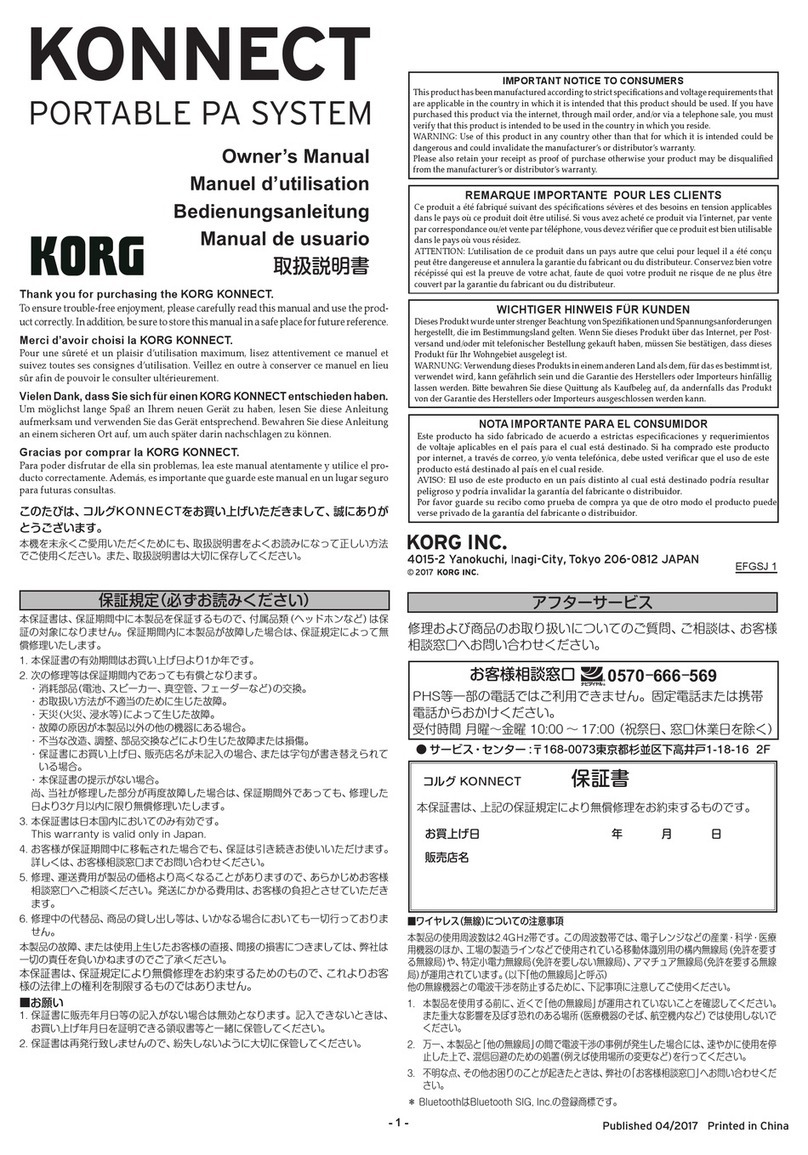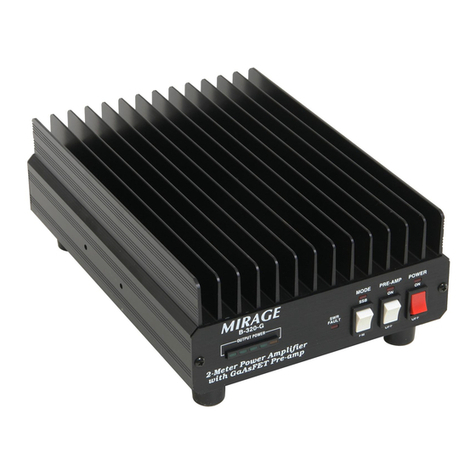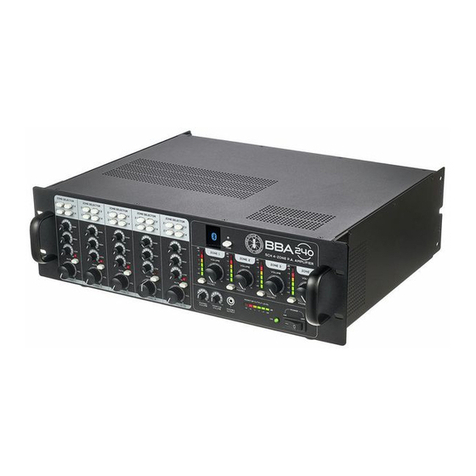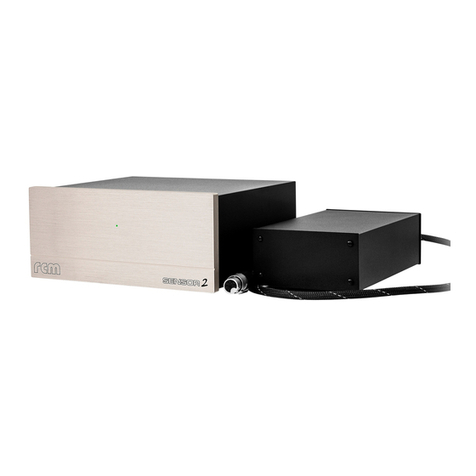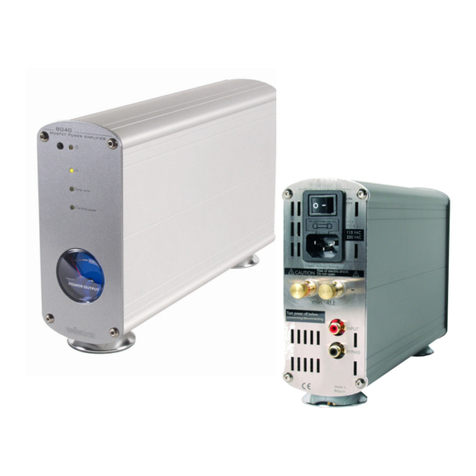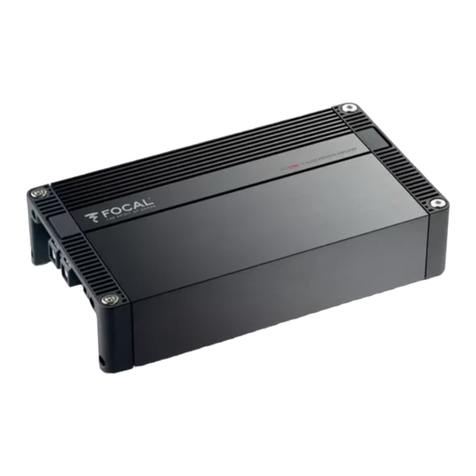Embla Sandman User manual

embla
®
Sandman Digital 32+ Amplifier
® ™
User Manual

Sandman Digital 32+ Amplifier User Manual
Applies to the Sandman Digital 32+ Amplifier, Sandman elink Adapter, and Sandman DC Expansion (DCX) Box
Copyright © 2012 Embla Systems. All rights reserved.
Issued May 2012. Printed in the USA or The Netherlands.
Document Number: D-1002-001, Revision 3.0
Document Item Number: 4280034
MANUFACTURER EUROPEAN REPRESENTATIVE
Embla Systems
1 Hines Rd, Suite 202
Kanata, ON K2K 3C7
Canada
Tel: +1.613.254.8877
Fax: +1.613.270.0627
Natus Europe GmbH
Robert-Koch-Str. 1
82152 Planegg
Germany
Tel: +49 089 83942-0
Fax: +49 089 83942-777
TOLL-FREE IN NORTH AMERICA: 888 NO APNEA (888.662.7632)
Disclaimer
This document may contain technical inaccuracies or typographical errors. Embla does not accept any liability for
the use or misuse, direct or indirect, of this product. Users must accept all responsibility for any results obtained by
or concluded from the products. All clinical conclusions and decisions that are made based on the use of this
product are the responsibility of the user. Embla does not accept any liability or responsibility for damages
arising out of the use of or inability to use this product.
Copyright
Information in this document, including URL and other Internet website references, is subject to change without
notice. Complying with all applicable copyright laws is the responsibility of the user. Without limiting the rights
under copyright, no part of this document may be altered for any purpose, without the express written permission
of Embla. The subject matter in this document is the express property of Embla. Unless specifically provided in any
written license agreement from Embla, the furnishing of this document does not give you any license to these
trademarks, copyrights, or other intellectual property.
Trademarks
Embla, Sandman, and Sandman Elite are registered trademarks of Embla Systems. Sandman Digital 32+ and
Sandman elink are trademarks of Embla Systems. All other trademarks are the property of their respective
owners.
0051
The Sandman Digital 32+ Amplifier is certified to carry the CE mark. The CE mark is a declaration
that the Sandman Digital 32+ Amplifier is in compliance with the directive for medical devices set
forth by the European Union.
The cCSAus mark is a safety symbol that shows the product has been independently tested and
certified to applicable U.S. and Canadian product safety standards.
MANUFACTURED IN ITALY BY:
EBNeuro S.p.A.
via Pietro Fanfani 97/A
50127 Firenze
ITALY
Distributed by Embla Systems.

Table of Contents
1. General Warnings and Cautions ......................................................................................................... 1
1.1. intended use .......................................................................................................................................... 1
1.2. safety information and document conventions................................................................................ 1
1.3. warnings ................................................................................................................................................ 1
1.4. amplifier casing symbols ..................................................................................................................... 2
1.5. electromagnetic compatibility............................................................................................................. 3
1.5.1. recommended distance from Radio Frequency systems....................................................4
2. Safety .................................................................................................................................................. 6
2.1. operational environment ..................................................................................................................... 6
2.1.1. electrical safety.........................................................................................................................7
2.1.2. patient leakage current............................................................................................................8
2.1.3. patient connection....................................................................................................................8
2.2. LCD display........................................................................................................................................... 8
2.3. declaration of conformity .................................................................................................................... 9
2.4. caution for the U.S. market.................................................................................................................. 9
3. Introduction ...................................................................................................................................... 10
3.1. Sandman Digital 32+™ amplifier (SD32+)...................................................................................... 10
®
3.2. headbox................................................................................................................................................ 11
connectors.........................................................................................................................................11
electrode sockets ..............................................................................................................................12
3.3. amplifier............................................................................................................................................... 15
ports...................................................................................................................................................16
sockets ...............................................................................................................................................16
3.4. LCD display......................................................................................................................................... 17
3.5. integrated pulse oximeter.................................................................................................................. 18
3.6. Sandman elink™ adapter .................................................................................................................... 19
3.7. power supply ...................................................................................................................................... 20
3.7.1. external medical grade ac/dc adapter ................................................................................20
3.7.2. amplifier power modes.........................................................................................................21
3.7.3. surge protection .....................................................................................................................21
3.8. DC expansion box............................................................................................................................... 21
inputs.................................................................................................................................................22
4. Software Driver Installation .............................................................................................................23
5. Amplifier System Assembly..............................................................................................................24
5.1. connecting the headbox to the amplifier ......................................................................................... 24
5.2. connecting the amplifier to the sandman elink adapter .................................................................. 24
5.3. connecting the external power supply to the amplifier system ................................................... 24
5.4. connecting the DC expansion box to the computer (serial connection)...................................... 25
5.5. connecting the DC expansion box to the computer (USB connection)........................................ 25
6. Calibration.........................................................................................................................................27
6.1. system record calibration .................................................................................................................. 27
7. Maintenance .....................................................................................................................................28
7.1. safety checks........................................................................................................................................ 28
7.2. operational environment electrical equipment .............................................................................. 28
7.3. amplifier calibration........................................................................................................................... 28
i

7.4. cables and connectors......................................................................................................................... 28
7.5. cleaning ................................................................................................................................................ 29
8. Specifications ....................................................................................................................................30
8.1. system specifications.......................................................................................................................... 30
8.2. environmental operating conditions................................................................................................ 31
8.3. environmental conditions for storage.............................................................................................. 31
8.4. amplifier specifications...................................................................................................................... 31
8.4.1. general amplifier specifications ...........................................................................................31
8.4.2. filters........................................................................................................................................32
8.4.3. resolution, full scale range, noise.........................................................................................32
8.4.4. sampling rate..........................................................................................................................33
8.5. headbox specifications ....................................................................................................................... 33
8.6. external medical grade AC/DC adapter specifications ................................................................ 34
8.6.1AULT SW173........................................................................................................................34
8.6.2SINPRO MPU50-106 ...........................................................................................................34
8.7. Sandman elink™ adapter................................................................................................................... 35
®
8.8. DC expansion box specifications...................................................................................................... 35
8.8.1. technical characteristics.........................................................................................................35
8.8.2. environmental conditions.....................................................................................................36
8.9. pulse oximeter performance ............................................................................................................. 36
List of Figures
Figure 1. the SD32+ system...................................................................................................................... 11
Figure 2. the headbox amplifier connection port .................................................................................. 12
Figure 3. removable patient box (headbox) link port ........................................................................... 12
Figure 4. headbox to amplifier cable....................................................................................................... 12
Figure 5. headbox electrode sockets........................................................................................................ 13
Figure 6. SD32+ amplifier’s external connections (front)..................................................................... 15
Figure 7. SD32+ amplifier’s external connections (back) ..................................................................... 15
Figure 8. Sandman elink adapter............................................................................................................... 19
Figure 9. fiber optic cable.......................................................................................................................... 20
Figure 10. external medical grade ac/dc adapter ................................................................................. 20
Figure 11. power transfer cable ............................................................................................................... 21
Figure 12. dc expansion box input sockets............................................................................................. 22
Figure 13. SD32+ amplifier dc expansion box cable ............................................................................. 25
Figure 14. typical SD32+ system set-up.................................................................................................. 26
List of Tables
Table 1. electromagnetic emission............................................................................................................. 3
Table 2. electromagnetic immunity........................................................................................................... 4
Table 3. recommended distances............................................................................................................... 5
Table 4. SD32+ amplifier headbox sockets............................................................................................. 14
ii

SD32+
System General Warnings and Cautions
1. General Warnings and Cautions
This document contains proprietary information. No part of this publication may be reproduced
in any form without written permission from Embla Systems.
1.1. intended use
The Sandman®Digital 32+™ Amplifier ("SD32+") is intended to be used by or under the direction
of a physician for acquisition of EEG, polygraphy, and polysomnography signals and
transmission of these signals to a PC during recording of neurophysiology examinations.
1.2. safety information and document conventions
The following table describes the safety and document conventions found in this manual:
Warning The Warning message appears in this manual before procedures or tasks
that must be strictly observed to avoid patient harm, inaccurate
measurements, or loss of data.
Caution The Caution message appears in the manual before procedures or tasks that
must be strictly observed to avoid damage to the product.
Note The Notes message contains important information to help the operator
complete a procedure or task correctly.
1.3. warnings
1. Do not disassemble the SD32+ or Headbox.
2. All connections on the Headbox are isolated from the ground of your building’s
electrical system (AC power ground). This type of insulation is known as “floating
isolation”. To avoid injury to the patient, do not connect input signals to the
Headbox from devices that are not equipped with floating isolation.
3. To maintain the SD32+ electrical isolation ensure that neither the patient nor any
conductive part connected to the patient (such as electrodes or sensors) comes into
contact with any conductive material.
4. Verify that the building’s electrical wiring is in good condition and properly
grounded. To ensure the safety of both patient and technician make certain that any
AC powered device connected to the SD32+ is properly grounded.
5. Always follow the safety precautions outlined in chapter 2. Safety on page 6of this
manual.
6. Place the computer outside of the patient area. If this is not possible, power the
computer through a dedicated isolation transformer.
7. Carefully route and secure sensor cables to avoid patient entanglement or
strangulation.
1

General Warnings and Cautions
SD32+
System
1.4. amplifier casing symbols
This symbol identifies ports or sockets equipped with a Type BF level of electrical
isolation in accordance with IEC60601-1.
This symbol prompts the user to refer to this manual for proper usage and safety
instructions.
This symbol identifies input connectors.
This symbol identifies output connectors.
This symbol identifies the manufacturing date
REF This symbol identifies the part number of the device
SN This symbol identifies the serial number of the device
2

SD32+
System General Warnings and Cautions
1.5. electromagnetic compatibility
This device is designed for use in environments that comply with IEC 60601-1-2:2001 as indicated
in the tables shown. You must ensure that the device is used in compliance with the IEC
standards.
Emission Test Compliance Electromagnetic Environment
Radiated and Conducted RF
emission
CISPR 11
Class B The device is suitable for use in domestic and
other environments that are connected to a low
voltage power supply.
Group 1 The internal operation uses a low RF. The
emission is not likely to cause interference with
nearby electronic equipment.
Harmonic emission
IEC 61000-3-2
Complies The device may be connected directly to a low
voltage supply using an electrical ground.
Voltage fluctuations/flicker
emissions
IEC 61000-3-3
Complies The device may be connected directly to a low
voltage supply using an electrical ground.
Table 1. electromagnetic emission
Immunity Test IEC 60601-1-2 Test Level Compliance Electromagnetic
environment
Electrostatic
Discharge
(ESD)
IEC 61000-4-2
6 kV direct contact
8 kV through air IEC 60601-1-2 Test
Levels Residential
(Note 1)
Electrical fast
transient/burst
IEC 61000-4-4
2 kV for power supply line
1 kV for input/output line
>3m
IEC 60601-1-2 Test
Levels Residential
(Note 2)
(Note 3)
Surge
IEC 61000-4-5 1 kV differential mode
2 kV common mode IEC 60601-1-2 Test
Levels Residential
(Note 2)
(Note 3)
Voltage dips,
short
interruptions
and voltage
variation on
power supply
input lines
IEC 61000-4-11
0% of rated voltage (voltage
dip 100%) for 0.5 cycles
40% of rated voltage
(voltage dip 60%) for 5
cycles
70% of rated voltage
(voltage dip 30%) for 25
cycles
0% of rated voltage (voltage
dip 100%) for 5 cycles
Residential
(Note 2)
(Note 3)
3

General Warnings and Cautions
SD32+
System
4
Immunity Test IEC 60601-1-2 Test Level Compliance Electromagnetic
environment
Magnetic fields
at ground
frequency
(50/60Hz)
IEC 61000-4-8
3 A/m
Radiated RF
fields
IEC 61000-4-3
Non-life-supporting
equipment
3 V/m
From 80 MHz to 2.5 GHz
IEC 60601-1-2 Test
Levels Residential
(Note 4)
Conducted RF
fields
IEC 61000-4-6
Non-life-supporting
equipment
3 V
From 150 kHz to 80 MHz
Measures to observe
Note 1 – The floor should be antistatic (wood, ceramic, etc.). If carpeted, the relative humidity
should be maintained at 30%.
Note 2 – The main power supply must be of residential, commercial, or medical grade.
Note 3 – If operating for an extended period, a UPS system must be provided in the event of a
power outage.
Note 4 – Mobile or portable RF communication devices should be used at greater distances than
those provided in table 3.
Table 2. electromagnetic immunity
1.5.1. recommended distance from Radio Frequency systems
It is not recommended to use RF transmitting devices near the SD32+ digital amplifier. RF
transmitting devices can cause interference with the device and impact the quality of the signals
being acquired during use.
To prevent RF interference it is recommended to maintain a minimum distance between the
SD32+ digital amplifier and the RF transmitting device being used; such as cell/mobile phones.
The following table shows recommended distances that the SD32+ digital amplifier should
remain from some common RF transmitting devices.
RF Source Typical Rated
Power (W) Distance
(m)
Microcellular phone CT1, CT2, CT3 0.01 0.3
DECT cellular phone, Wireless Information
Technology equipment (modems, LAN's) 0.25 2
Cellular phone, hand-held (USA) 0.6 2
Cellular phone, hand-held (GSM and NMT,
Europe DECS 1800) 2
8 4
7
Walkie-talkie (Rescue, police, fire, maintenance) 5 3
Cellular phone, bag 16 10
Mobile radio (Rescue, police, fire) 100 30

SD32+
System General Warnings and Cautions
For transmitters, the maximum output power of which is not within the values above, the
recommended distance can be estimated by using the following calculations:
For transmitters using a frequency range from 150 kHz to 80 MHz and 80MHz to 800 MHz, the
distance can be estimated as follows: D = 1.2√P
For transmitters using a frequency range from 800 MHz to 2.5 GHz, the distance can be
estimated as follows: D = 2.3√P
P = the rated power of the transmitter in Watts (W).
Note: Always use the greater distance provided.
Note: These values are general guidelines as electromagnetic fields can be compromised in
the presence of structures, objects, and people.
Table 3. recommended distances
Always remember that the intensity of the electromagnetic field generated by a fixed transmitter
(base station for radio, TV, Cell service, etc.) cannot be predicted.
Additional measures may be required if the electromagnetic field exceeds the specified intensity
shown in table 3.
5

Safety
SD32+
System
2. Safety
Please follow all warnings and cautions listed in this manual to ensure the safety of the patient
and the operator.
Warning: Before using the SD32+ system, ensure that it satisfies all safety requirements.
Safety checks should be performed periodically and no less than twice a year.
2.1. operational environment
The SD32+ amplifier is designed to work in the following environmental conditions:
temperature 5°C to 40°C
relative humidity 30% to 75% RH
atmospheric pressure 700 to 1060 hPa
Avoid condensation.
Use caution when operating the amplifier after moving it between locations with different
temperatures. Condensation (slight moisture accumulation or misting over internal or external
surfaces of the amplifier) may occur if the amplifier is moved rapidly from a cold location to a
warmer location. Wait for the condensation to evaporate completely before supplying power to
and using the amplifier.
Avoid flammable vapors or gases.
Do not use the amplifier in atmospheres with high oxygen concentration or in buildings where
flammable substances or anesthetic agents are present.
Avoid contact with liquids.
The amplifier and its internal parts are not protected against the inflow of liquids. Avoid
exposing the amplifier to moisture or using the amplifier where such a risk is present.
Components that have been penetrated by liquids must be cleaned immediately and checked by
authorized personnel.
Ensure proper electrical grounding.
The building’s electrical wiring must be properly grounded. When the amplifier is connected to
other AC powered devices ensure those devices are grounded. This protection is essential for the
safety of both the patient and the technician.
Avoid strong magnetic fields.
Keep the amplifier away from sources of induced electromagnetic fields to avoid possible
instability or malfunction. The SD32+ system is compliant with the EMC (Electromagnetic
Compatibility) requirements specified by the 89/336/EEC European directive.
Avoid short wave or microwave devices.
Therapeutic short wave or microwave devices may cause instability and interfere with the
amplifier’s functions. Do not place the amplifier near X-ray or diathermy devices.
6

SD32+
System Safety
2.1.1. electrical safety
Use only the power supply distributed with the SD32+ system.
The SD32+ system is specifically designed to function with only the provided AC/DC Adapter.
See section 3.7.1. external medical grade ac/dc adapter on page 20 for more information.
Use caution when operating the amplifier in conjunction with other instruments.
If the patient is connected to several instruments at the same time remember that the sum of
leakage currents from all of the equipment must be considered when assessing patient safety.
Avoid switching the amplifier ON while the patient is connected.
To ensure patient safety, it is necessary to connect the patient after the equipment is powered up
and working correctly.
Avoid switching the amplifier OFF while the patient is connected.
To ensure patient safety, it is necessary to disconnect the patient before powering down the
equipment.
It is not recommended to use the amplifier while using radio-frequency instruments.
In the event the SD32+ is used in a room at the same time as a Radio-Frequency (RF) instrument,
ensure the RF instrument is kept as far as possible from the electrodes as close proximity may
increase the risk of RF currents flowing through the electrodes and may result in burns. This risk
may be further mitigated by using electrodes with a larger surface area to limit the RF current
density. If these mitigations are not possible, it is recommended to disconnect the patient from
the SD32+ before using radio-frequency instruments.
The amplifier is not protected against defibrillator discharges.
If a defibrillator must be used disconnect the patient from the amplifier to avoid the risk of
burning the patient along electrode contact areas and damaging the amplifier.
Avoid contacting the patient and the electrodes with conductive metal items.
Do not allow the patient, or any conductive parts connected to the patient such as electrodes or
sensors, to contact any other conductive items, especially an electrical ground. The entire input
circuit the patient is connected to is electrically isolated (known as “floating isolation”) and
contact with conductive items could compromise patient safety.
When connecting the SD32+ amplifier to other instruments, observe the IEC 60601-1-1 and IEC
60601-1-2 safety standards.
Only connect the SD32+ to devices when the safety of the patient, technologist, and the
environment are not compromised. Refer to the device’s manual, manufacturer, or authorized
servicing centre for information on the possible effects of coupling the device with the SD32+
amplifier.
Replace damaged parts immediately.
Cables, connectors, accessories, or other parts of the amplifier must be replaced immediately
when they show signs of malfunction or damage. In these cases, contact Embla Technical
Support.
Use only accessories or peripherals specified by Embla Systems.
Only use accessories and peripherals specified by Embla Systems in this manual as they have
been tested with the SD32+ amplifier for safety. Accessories and consumer goods supplied by
other manufacturers do not guarantee the safe or correct operation of the SD32+ amplifier. Use
peripherals in compliance with the standards of the class to which they belong.
There is no increased safety risk for Pacemaker patients with the SD32+ Amplifier.
The Sandman System when used with the SD32+ Amplifier does not increase the safety risk for
pacemaker patients as long as the pacemakers comply with the EN50061 standard of electrical
7

Safety
SD32+
System
safety of medical devices. Nevertheless, it is not advisable to do an impedance test on pacemaker
patients since it might cause the pacemaker to switch to the interference mode. Prior to using the
system with pacemaker patients, the operator should consult the pacemaker’s accompanying
documents regarding its certifications and requirements of use, or if necessary, contact the
producer.
2.1.2. patient leakage current
The maximum patient leakage current from the SD32+ amplifier, measured according to the test
methods of IEC 60601-1, is less than 100 μA.
Warning: When using the SD32+ amplifier in conjunction with other instruments the sum of
leakage currents from all of the devices may exceed 100μA.
2.1.3. patient connection
Connection between the patient and the SD32+ amplifier should only be made through the
electrode sockets on the Headbox or the Pulse Oximetry Sensor port (using a pulse oximeter
cable approved by Embla Systems). Connecting the patient to the amplifier by any other means
may constitute an unsafe condition that could result in injury to the patient.
Warnings: Standard PSG recording guidelines recommend that all patient monitoring devices
connected to an electrical outlet be turned on before connection to the patient.
Once the device is powered up, you may then connect the patient to the device and
begin collection. At the same time, you must disconnect the patient before you
power the device down.
All connections on the Headbox are isolated from the AC power ground. Do not
allow these connections to come into contact with earth ground or AC power
ground as this constitutes an unsafe condition that could result in serious injury to
the patient.
Always use electrodes or sensors cleared for commercial use in your jurisdiction.
It is strongly recommended to check the overall functionality of the system prior
to starting a collection. If anomalies or malfunctions are noticed disconnect the
patient from the system, switch off the system, and contact Embla Technical
Support.
If “flat” traces are observed during a collection and are not rectified by simple
corrections (i.e. poor electrode connection, broken lead, etc.) disconnect the patient
and contact Embla Technical Support.
If skin irritation occurs during collection discontinue the collection and disconnect
the patient. Refer to any directions for use included with the sensor(s) and or paste
involved for further information.
2.2. LCD display
Treat the LCD with great care. If the LCD glass should break and spill liquid, avoid coming in
contact with the liquid. If anyone is exposed to the liquid, carefully wash the affected area with
water for at least 15 minutes. Should the individual experience any irritation, discomfort, or other
symptoms after this period, seek medical assistance immediately.
8

SD32+
System Safety
2.3. declaration of conformity
The SD32+ amplifier meets the requirements of Annex II of the 93/42/EEC Directive on Medical
Devices (MDD). For these reasons, the equipment is marked with the CE mark. IMQ S.p.A.
(Milan, Italy) issues the approval as the Notified Body notified by the European Commission. The
IMQ notified body identifier number is 0051.
The equipment is marked with the cCSAus quality mark. This safety mark is valid for both
Canadian and U.S. markets.
2.4. caution for the U.S. market
Federal law restricts this device to sale by or on the order of a physician.
9

Introduction
SD32+
System
3. Introduction
3.1.
Sandman
®
Digital 32+
™ amplifier (
SD32+
)
The SD32+ amplifier is a self contained, fully programmable, digital amplifier that is designed
specifically for use with the Sandman Elite®software (version 7.2 or greater) and the Sandman
Spyder™ software. It collects physiological signals from patients through electrodes/sensors;
amplifies and converts them to digital data; converts the data to an optical signal; then sends the
data to the Sandman elink™ Adapter via a fiber optic link (the Sandman elink then passes the data
to the computer running the Sandman Elite software).
The SD32+ amplifier has the following features; provides electrical references for individual
input channels, generates calibration pulses, allows for impedance testing, provides a dynamic
range (gain), provides a choice of sampling rate, and is equipped with anti-alias signal filtering.
The SD32+ system consists of seven key components: the Headbox, Amplifier, Headbox to
Amplifier Cable, Sandman elink Adapter, pulse oximetry sensor, External Medical Grade AC/DC
Adapter, and the DC expansion box. These components can be seen in Figure 1. the SD32+ system.
The Headbox provides an electrical connection between the patient and the SD32+ amplifier
using electrodes.
The Headbox to Amplifier Cable allows the Headbox to function without being physically
mounted to the SD32+ amplifier allowing for greater flexibility in lab setups.
The Sandman elink Adapter receives optical digital data from the SD32+ amplifier and converts it
for transmission over an Ethernet network to relay it to the computer running the Sandman Elite
software. The SD32+ amplifier communicates with the Sandman elink Adapter via fiber optic
cable.
The External Medical Grade AC/DC Adapter (“AC/DC Adapter”) provides an isolated +15V
direct current (DC) voltage to the SD32+ amplifier through the Sandman elink. The +15V DC
output is electrically isolated from the AC supply mains using methods compliant with the
International Electrotechnical Commission’s (IEC) safety standard IEC 601-1 for Class I, type B
equipment. The AC/DC Adapter is plugged into an Uninterruptible Power Supply (UPS); which,
in turn, is plugged into an electrical outlet. The UPS is used to prevent undesirable effects of the
electrical system such as electrical noise; power outages, sags, or surges; etc. from adversely
affecting the performance of the SD32+ system.
The SD32+ amplifier’s internal Pulse Oximeter receives data from a finger probe attached to the
patient. This data is then sent to the Sandman elink Adapter; which passes it on to the computer
running the Sandman Elite software.
The DC expansion box accepts analog input signals from a variety of DC devices (e.g. CPAP or
pressure) and sends their signals directly to the computer running the Sandman Elite software.
10

SD32+
System Introduction
DC Expansion Box
Figure 1. the SD32+ system
3.2. headbox
Patient electrodes and sensors plug into the SD32+ amplifier headbox. There are 68 input sockets
that accept 1.5-mm electrode safety plugs including 32 AC monopolar input sockets, 8 pairs of
AC bipolar input sockets, 3 neutral input sockets, 13 isolated ground input sockets, 2 temperature
input sockets, and 2 calibration signal output sockets.
connectors
The Headbox has two different ports that can be used to interface with the SD32+ amplifier.
11

Introduction
SD32+
System
Amplifier Connection Port – This port allows the Headbox to be physically connected to the
amplifier (this process is referred to as “docking” the Headbox). See Figure 2. the headbox amplifier
connection port for an illustration of this port.
Figure 2. the headbox amplifier connection port
Removable Patient Box (Headbox) Link Port – This port connects the Headbox to the amplifier
using the six-foot Headbox to Amplifier Cable. The cable allows users to place the Headbox near
the patient and allows the patient to be easily disconnected from the amplifier without having to
remove electrodes from the patient. The cable should be kept clear of other devices or cables in
order to achieve the best signal performance. See Figure 3. removable patient box (headbox) link for
an illustration of this port. See Figure 4. headbox to amplifier cable for an illustration of this cable.
Note: When the Headbox’s Removable Patient Box Link port is not in use replace the plastic
cover provided with the SD32+ amplifier to prevent dust build-up on this connector.
Figure 3. removable patient box (headbox) link
port
Figure 4. headbox to amplifier cable
electrode sockets
The Headbox has six types of electrode sockets: Monopolar, Bipolar, Neutral (NE), Isolated
Ground (ISO GND), Temperature, and Calibration. Figure 5. headbox electrode sockets displays the
Headbox’s general appearance and the layout of the electrode sockets.
12

SD32+
System Introduction
Figure 5. headbox electrode sockets
Monopolar Input Sockets – These input sockets, labeled with numbers ranging from “1” to “32”,
accept monopolar signals from the patient. The amplified signal is the difference in potential
between a monopolar input socket and its reference electrode socket. Channels collected using
these input sockets may be referenced to the Neutral (NE) input sockets.
Bipolar Input Sockets – These input sockets, labeled with letters ranging from “A” to “H”,
accept inputs from bipolar monitoring devices such as a respiratory belt, snore microphone,
thermocouple, or any device with a bipolar output. The amplified signal is the difference of
potential between the “+” and “–” connection.
Neutral (NE) Sockets – These sockets accept monopolar analog signals and may be used as an
input reference for sites plugged into the sockets labeled “1” to “32” (i.e. they may be used to
accept a general reference input such as CZ for numbered AC channel inputs). There are three
parallel neutral input sockets on the Headbox labeled “NE”. This is also used as the reference
when impedance testing is done.
Isolated Ground (ISO GND) Sockets – These sockets, labeled “ISO GND”, accept and isolate the
patient ground to prevent leakage current from making a direct path to the patient. The 13
Isolated Ground input sockets connect the patient to ground.
Warning: The output from any DC device plugged directly into the Headbox must provide
an electrically isolated signal. Do not plug a non-isolated DC signal into the
Headbox as this compromises patient safety.
Temperature Sockets – These two sockets, labeled “T°”, accept input from an external
temperature probe. These input sockets are disabled if you have connected the Headbox to the
amplifier with the Headbox to Amplifier Cable.
Calibration Sockets – When these two sockets, labeled “C”, are enabled, they output the
amplifier’s calibration signal. You can connect the signal to any input (including the lead used for
the connection) for testing. These sockets are disabled if the Headbox is connected to the
amplifier with the Headbox to Amplifier Cable.
13

Introduction
SD32+
System
14
The following table summarizes the Headbox electrode sockets and their characteristics:
input socket
label
socket type current
type
function Gain setting +
resolution
Max. input
A - H Bi-polar AC Accepts channel signal
input and reference
‘High’
1 µV/8 bits 8mV p-p
‘Low’
2 µV/bit 128mV p-p
1 - 24 Mono-polar AC Accepts channel signal
input
‘High’
1 µV/8 bits 8mV p-p
‘Low’
2 µV/bit 128mV p-p
25 - 32 Mono-polar AC/DC Accepts channel signal
input
‘High’
1 µV/8 bits 8mV p-p
‘Low’
2 µV/bit 128mV p-p1
‘DC1’
10 µV/bit 640mV p-p2
‘DC2’
20 µV/bit 1.28 V p-p3
‘DC23’
100 µV/bit 6.4 V p-p4
Neutral (NE) N/A N/A References mono-
polar channel inputs
Isolated Ground
(ISO GND) N/A N/A Connects patient
ground
To
(Temperature) Bi-polar DC Accepts a temperature
probe input when the
Headbox is docked
C (Calibration) Bi-polar AC Generates calibration
pulse output when the
Headbox is docked
Table 4. SD32+ amplifier headbox sockets
1Includes 28 mVp-p offset
2Includes 140 mVp-p offset
3Includes 280 mVp-p offset
4Includes 1.4 Vp-p offset

SD32+
System Introduction
3.3. amplifier
The SD32+ amplifier has two sockets, five ports, a graphic LCD display, and five menu control
buttons as illustrated in Figure 6. SD32+ amplifier’s external connections (front) and Figure 7. SD32+
amplifier’s external connections (back).
Figure 6. SD32+ amplifier’s external connections (front)
Figure 7. SD32+ amplifier’s external connections (back)
15

Introduction
SD32+
System
ports
Headbox Connection Port – This port connects the Headbox directly to the amplifier when the
Headbox is “docked”.
Patient Box Link Port – This port connects the Headbox to the amplifier when using the
Headbox to Amplifier Cable.
Note: When the Patient Box Link port is not in use replace the plastic cover provided to
prevent dust build up on this connector.
Optical Link Port – This port connects the amplifier to the Sandman elink Adapter using a fiber
optic cable.
Pulse Oximetry Sensor Port – This port accepts signals from an external finger probe and sends
them to the internal pulse oximeter.
Warning: Always use sensors that have been approved by Embla Systems. Sensors must also
be cleared for commercial use in your jurisdiction. The oximeter does not possess
alarm management capabilities and is not intended for continuous patient
monitoring.
Serial I/O Port – This port is reserved for future development.
sockets
DC In Socket – This socket accepts the 15V direct current (DC) voltage from the AC/DC
Adapter.
Warning: The DC In socket is only designed for use with the External Medical Grade
AC/DC Adapter provided with the SD32+ amplifier. Do not connect anything else
to this socket.
Isolated Aux I/O – This socket is reserved for future development.
Warning: Do not connect any device to the Isolated Aux I/O socket that has not been
specified as safe by Embla Systems. Such an action may compromise the safety of
the operator and/or patient.
16
This manual suits for next models
1
Table of contents
